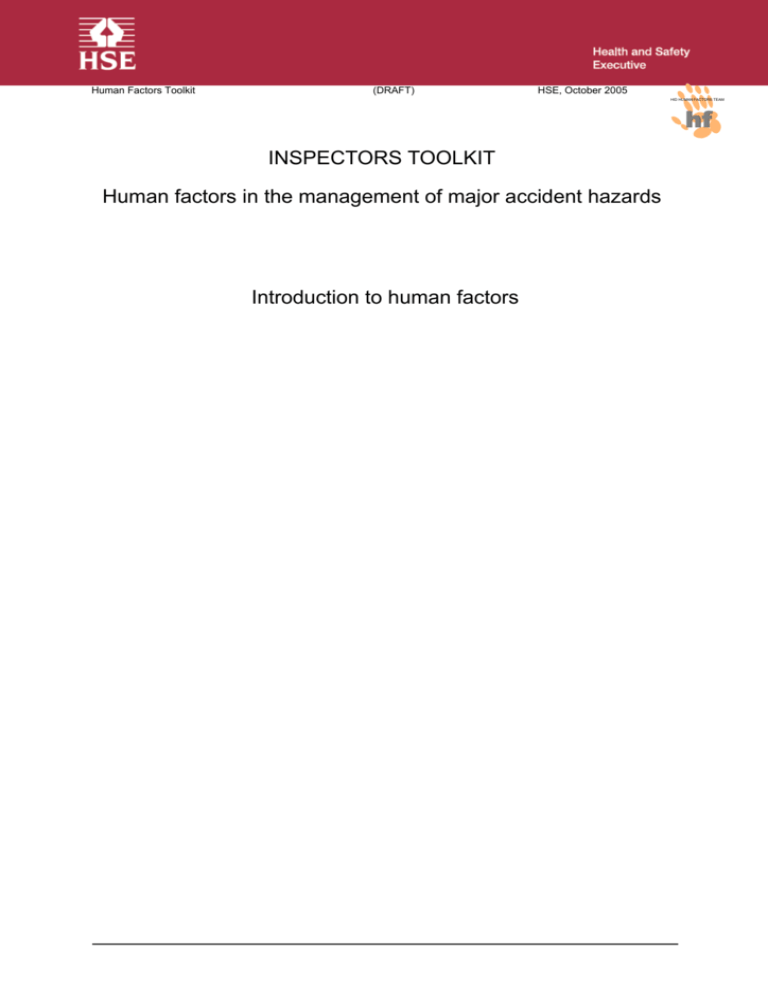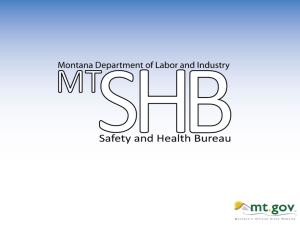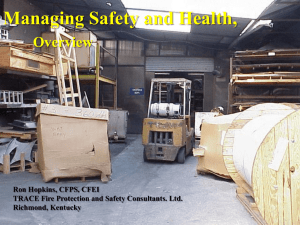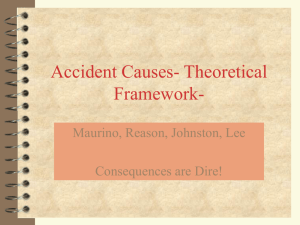INSPECTORS TOOLKIT - Human factors in the management
advertisement

Human Factors Toolkit (DRAFT) HSE, October 2005 HID HUMAN FACTORS TEAM hf INSPECTORS TOOLKIT Human factors in the management of major accident hazards Introduction to human factors Introduction to human factors What we mean by human factors Reducing error and influencing behaviour (HSG48) is the key document in understanding HSE’s approach to human factors. It gives a simple introduction to generic industry guidance on human factors, which it defines as: ‘Human factors refer to environmental, organisational and job factors, and human and individual characteristics, which influence behaviour at work in a way which can affect health and safety’ This definition includes three interrelated aspects that must be considered: the job, the individual and the organisation: • • • The job: including areas such as the nature of the task, workload, the working environment, the design of displays and controls, and the role of procedures. Tasks should be designed in accordance with ergonomic principles to take account of both human limitations and strengths. This includes matching the job to the physical and the mental strengths and limitations of people. Mental aspects would include perceptual, attentional and decision making requirements. The individual: including his/her Culture & working environment competence, skills, personality, National, local & workplace cultures, social & community values … attitude, and risk perception. Individual characteristics influence behaviour in complex ways. Some characteristics such as personality are fixed; others such as skills and Job: Individual: attitudes may be changed or Task, workload, Competence, skills, enhanced. environment, display & personality, attitudes, controls, procedures … risk perception… The organisation: including work patterns, the culture of the workplace, resources, communications, leadership and so on. Such factors are often overlooked during the Organisation: design of jobs but have a significant Culture, leadership, influence on individual and group resources, work patterns, behaviour. communications … In other words, human factors is concerned with what people are being asked to do (the task and its characteristics), who is doing it (the individual and their competence) and where they are working (the organisation and its attributes), all of which are influenced by the wider societal concern, both local and national. People are involved in the working system because of a number of strengths: for example, versatility in providing a link between a number of tasks, knowledge and judgement, ease of communicating with and eliciting a response. Hence, human acts and omissions can play a role in the initiation, mitigation, escalation and recovery phases of an incident. Human factors interventions will not be effective if they consider these aspects in isolation. The scope of what we mean by human factors includes organisational systems and is considerably broader than traditional views of human factors/ergonomics. Human factors can, and should, be included within a good safety management system and so can be examined in a similar way to any other risk control system. Categorising human failure It is important to remember that human failures are not random; there are patterns to them. It is worth knowing about the different failure types because they have different causes and influencing factors and as a consequence the ways of preventing or reducing the failures are similarly different. There are three types of human failures (unsafe acts) that may lead to major accidents: Unintentional errors: • • Errors (slips/lapses) are “actions that were not as planned” (unintended actions). These can occur during a familiar task e.g. omissions like forgetting to do something, which are particularly relevant to repair, maintenance, calibration or testing. These are unlikely to be eliminated by training and need to be designed out. Mistakes are also errors, but errors of judgement or decision-making (“intended actions are wrong”) - where we do the wrong thing believing it to be right. These can appear in situations where behaviour is based on remembered rules or familiar procedures or unfamiliar situations where decisions are formed from first principles and lead to misdiagnoses or miscalculations. Training is the key to avoiding mistakes. e.g. changing down into 3rd gear when you intended (correctly) to change up into 5th. e.g. making a poor judgement when overtaking, leaving insufficient room to complete the manoeuvre in the face of oncoming traffic. Intentional errors: • Violations differ from the above in that they are intentional (but usually well-meaning) failures, such as taking a shortcut or non-compliance with procedures e.g. deliberate deviations from the rules or procedures. They are rarely wilful (e.g. sabotage) and usually result from an intention to get the job done despite the consequences. Violations may be situational, routine, exceptional or malicious as outlined below. e.g. speeding when you are late for an appointment. Routine violations: a behaviour in opposition to a rule, procedure, or instruction that has become the normal way of behaving within the person’s peer/work group. Exceptional violations: these violations are rare and happen only in unusual and particular circumstances, often when something goes wrong in unpredicted circumstances e.g. during an emergency situation. Situational violations: these violations occur as a result of factors dictated by the worker’s immediate work space or environment (physical or organisational). Acts of sabotage: these are self explanatory although the causes are complex ranging from vandalism by a de-motivated employee to terrorism. There are several ways to manage violations, including taking steps to increase their detection, ensuring that rules and procedures are relevant/practical and explaining the rationale behind certain rules. Involving the workforce in drawing up rules increases their acceptance. Getting to the root cause of any violation is the key to understanding and hence preventing the violation. Figure 5: Types of human error Unintended actions Slips Attention failures Plan of action satisfactory but action deviated from intention in some unintentional way Lapses Memory failures (errors) Rule-based Misapplication of good rule or application of a bad rule Knowledgebased No ready-made solution, new situation tackled by thinking out answer from scratch Routine Habitual deviation from regular practices Exceptional Non-routine infringement dictated by extreme local circumstances Situational Non-routine infringement dictated by local circumstances Mistakes Unsafe acts Intended actions Violations Acts of sabotage The likelihood of these human failures is determined by the condition of a finite number of ‘performing influencing factors’, such as distraction, time pressure, workload, competence, morale, noise levels and communication systems. Given that these factors influencing human performance can be identified, assessed and managed, potential human failures can also be predicted and managed. In short, human failures are not random events. The key message here is that human errors and rule breaking are largely predictable and therefore, can be identified and, most importantly, managed. We seek to encourage industry to tackle error reduction in a structured and proactive way, with as much rigour as the technical aspects of safety and make it an integrated part of their safety management system. Managing human failures – common pitfalls There is more to managing human failure in complex systems than simply considering the actions of individual operators. However, there is obvious merit in managing the performance of the personnel who play an important role in preventing and controlling major incidents, as long as the context in which this behaviour occurs is also considered. There are several mistakes that major hazard sites commonly make when assessing human performance. These include: • • • • • Treating operators as if they are superhuman, able to intervene heroically in emergencies, Providing precise probabilities of human failure (usually indicating very low chance of failure) without documenting assumptions/data sources, Assuming that an operator will always be present, detect a problem and immediately take appropriate action, Assuming that people will always follow procedures, Stating that operators are well-trained, when it is not clear how the training provided relates to major accident hazard prevention or control and without understanding that training will not effect the prevention of slips/lapses or violations, only mistakes, • • • • Stating that operators are highly motivated and thus not prone to unintentional failures or deliberate violations, Ignoring the human component completely, failing to discuss human performance at all in risk assessments, leading to the impression that the site is unmanned, Inappropriate application of techniques, such as detailing every task on site and therefore losing sight of targeting resources where they will be most effective, Producing grand motherhood statements that human error is completely managed (without stating exactly how). Managing human failures – three serious concerns The misconceptions discussed above can be summarised into three areas of concern, where major hazard sites do not adequately address human factors issues, which are: Concern 1: An imbalance between hardware and human issues and focusing only on engineering ones, Concern 2: Focussing on the human contribution to personal safety rather than to the initiation and control of major accident hazards and Concern 3: Focussing on ‘operator error’ at the expense of ‘system and management failures’. Concern 1: hardware vs human issues and the focus on engineering Despite the growing awareness of the significance of human factors in safety, particularly major accident safety, the focus of many sites is almost exclusively on engineering and hardware aspects, at the expense of ‘people’ issues. For example, a site may have determined that an alarm system is safety-critical and have examined the assurance of their electro-mechanical reliability, but they then fail to address the reliability of the operator in the control room who must respond to the alarm. If the operator does not respond in a timely and effective manner then this safety critical system will fail and therefore it is essential that the site addresses and manages this operator performance. Due to the ‘ironies of automation’1, it is not possible to engineer-out human performance issues. All automated systems are still designed, built and maintained by human beings. For example, an increased reliance on automation may reduce day-to-day human involvement, but increases maintenance, where performance problems have been shown to be a significant contributor to major accidents (see reference 15). Furthermore, where the operator moves from direct involvement to a monitoring and supervisory role in a complex process control system, they will be less prepared to take timely and correct action in the event of a process abnormality. In these infrequent events the operator, often under stress, may not have ‘situational awareness’ or an accurate mental model of the system state and the actions required. Concern 2: focus on personal safety There needs to be a distinct focus in the management system on major hazard issues, as the following diagram shows what is often the case: 1 Bainbridge, L. (1987). Ironies of automation. In New Technology and Human Error. Edited by Rasmussen, J., Duncan, K. & Leplat, J. John Wiley and Sons Ltd. Figure 6: Major accident vs personnel safety Event severity Major hazard accidents are here Frequency/probability ..but most of the management system, e.g. performance measures, audits, behaviour modification, etc. are aimed here The majority of major hazard sites still tend to focus on occupational safety rather than on process safety and those sites that do consider human factors issues rarely focus on those aspects that are relevant to the control of major hazards. For example, sites consider the personal safety of those carrying out maintenance, rather than how human errors in maintenance operations could be an initiator of major accidents. This imbalance runs throughout the safety management system, as displayed in priorities, goals, the allocation of resources and safety indicators. For example, ‘safety’ is measured by lost-time injuries, or LTIs. The causes of personal injuries and illhealth are not the same as the precursors to major accidents and are not an accurate predictor of major accident hazards, which may result in sites being unduly complacent. Notably, several sites that have recently suffered major accidents demonstrated good management of personal safety, based on measures such as LTIs. Therefore, the management of human factors issues in major accidents is different to traditional safety management. In his analysis of the explosion at the Esso Longford gas plant, Hopkins (2000)2 makes this point very clearly: “Reliance on lost-time injury data in major hazard industries is itself a major hazard.” and, “An airline would not make the mistake of measuring air safety by looking at the number of routine injuries occurring to its staff”. Clearly, a safety management system that is not managing the right aspects is as effective in controlling major accidents as no system at all. Performance indicators more closely related to major accidents may include the movement of a critical operating parameter out of the normal operating envelope. The definition of a parameter could be quite wide and include process parameters, staffing levels or the availability of control/mitigation systems. Many performance indicators will be site specific but examples are given below: 2 Hopkins, A. (2000). Lessons from Longford: The Esso Gas Plant Explosion. CCH Australia Ltd • • • • • • • • • • • • • • • • • Effectiveness of the training program; Number of accidental leakages of hazardous substances; Environmental releases; Process disturbances; Activations of protective devices; Time taken to detect and respond to releases; Response times for process alarms; Process component malfunctions; Number of outstanding maintenance activities; Maintenance delays (hours); Frequency of checks of critical components; Number of inspections/audits; Emergency drills; Procedures reviews; Compliance with safety critical procedures; Staffing levels falling below minimum targets; Non-compliance with company policy on working hours. e.g. if there is frequent operation of a pressure relief valve then cause of the pressure rise needs to be established and action taken e.g. is the maintenance of safety critical equipment being undertaken as planned and if not what is done about it. e.g. are the right drills being carried out in the right places, do they cover suitable scenarios, are all shifts involved, etc. It is critical that the performance indicators should relate to the control measures outlined by the site risk assessment. Furthermore, they should measure not only the performance of the control measures, but also how well the management system is monitoring and managing them. The Esso Longford report discussed above contains a particularly insightful section on the use, and misuse, of performance indicators at a major hazard site. Concern 3: focus on the front-line operator In general, most safety activities in complex systems are focussed on the actions and behaviours of individual operators – those at the sharp end. However, operators are often ‘set up’ to fail by management and organisational failures, a point adeptly made by Reason (1990)3: “Rather than being the main instigators of an accident, operators tend to be the inheritors of system defects created by poor design, incorrect installation, faulty maintenance and bad management decisions. Their part is usually that of adding the final garnish to a lethal brew whose ingredients have already been long in the cooking” (Reason, Human Error, 1990) Following the investigation of major incidents, it has become increasingly clear that the role of management and organisational factors must be considered, rather than placing responsibility solely with the operator. However, audits rarely consider issues such as the quality of management decision making or the allocation of resources. Furthermore, “safety culture” is seen as being something that operators have and it has been found, following the investigation of major accidents, that management have not acknowledged that the development and maintenance of a safe culture lie within the bounds of their responsibility. 3 Reason, J. (1990). Human Error. Cambridge University Press, Cambridge. ISBN 0 521 31419 4. “If culture, understood here as mindset, is to be the key to preventing major accidents, it is management culture rather than the culture of the workforce in general which is most relevant. What is required is a management mindset that every major hazard will be identified and controlled and a management commitment to make available whatever resources are necessary to ensure that the workplace is safe.” (Hopkins, Lessons from Longford, reference 2) Feedback from audits carried out by the Human Factors Team on major hazard sites often reveals areas that require attention in the management system which have not been identified (or reported) in previous audits. Audits of management systems frequently fail to report bad news. For example, following the Piper Alpha offshore platform fire it is reported that numerous defects in the safety management system were not picked up by company auditing. There had been plenty of auditing, but the inquiry reported that: “It was not the right quality, as otherwise it would have picked up beforehand many of the deficiencies which emerged in the inquiry” (B Appleton, Piper Alpha, 1994) Clearly, in addition to the performance of operators on specific tasks, there is also a human dimension to the decisions made and actions taken in the management of safety itself (for a fuller discussion, see Hurst, 19984). 4 Hurst, N.W. (1998). Risk assessment: The human dimension. Royal Society of Chemistry. Cambridge. ISBN 0 85404 554 6






